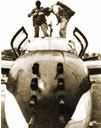|
 The three days of futile bloodshed haunted the both of them -- the CIA spook and the commander in chief he despised, John F. Kennedy. The three days of futile bloodshed haunted the both of them -- the CIA spook and the commander in chief he despised, John F. Kennedy."We both had scores to settle with Castro," the old, bullet-scarred commando recalls from his home in Tampa. "But I wasn't haunted in the same way that Kennedy was. I had nothing to feel guilty about." Such is Grayston L. Lynch's way of explaining his long, strange bond to a flawed president and a lost cause that began 37 years ago with the bloody, tragic, history-altering Bay of Pigs invasion and continued until 1967 in more than 2,000 secret CIA raids on Cuba from Miami. Lynch was our man on Cuba's Playa Giron beach on April 16, 1961 -- the white, "Tex-Mex" - speaking CIA agent who fired the first shot of the Bay of Pigs assault and then took desperate, unofficial command of the doomed force of 1,500 Cuban volunteers, most of them Miami exiles, recruited and trained -- then disavowed -- by the Kennedy administration. Sunday, at age 75, Lynch returns to Miami with a new book that vents bitterness and disillusionment, but celebrates the bravery of his comrades in arms, about 75 of whom died, and 1,250 of whom were captured and imprisoned. Many of them are now prominent and  successful Americans -- including Miami's Republican state Rep. Luis Morse, House Speaker pro tempore, then in command of the supply ship Houston. Lynch describes Morse's desperate beaching of the Houston in the Bay of Pigs after Cuban warplanes blew a 10-foot hole in its stern. successful Americans -- including Miami's Republican state Rep. Luis Morse, House Speaker pro tempore, then in command of the supply ship Houston. Lynch describes Morse's desperate beaching of the Houston in the Bay of Pigs after Cuban warplanes blew a 10-foot hole in its stern.Lynch hasn't seen any of the survivors of the 2506 Assault Brigade in years, but the Cuban volunteers who made up the force regard him as "one of the big warriors of this country," says Jose Dausa of the 2506 Brigade Association in Miami. In his book, Decision for Disaster: Betrayal at the Bay of Pigs (Brassey's, $24.95), Lynch returns the compliment: "The only heartening observation . . . was that the brigade had fought magnificently. Outnumbered in every battle by at least twenty to one, it had inflicted heavy casualties on Castro's forces at a rate of fifty to one." Much about the Bay of Pigs debacle -- a three-day battle that failed after President Kennedy canceled air support and disavowed American involvement -- already has been told in other books. But the mere fact that Lynch is alive and intact to tell his bullet-whizzing, ground-zero tale, which he wrote more than 20 years ago and only now has published, seems miraculous.  War wounds War woundsHe carries wounds from World War II's D-Day Normandy invasion, from the Battle of the Bulge, and from Heartbreak Ridge in Korea. He served with the Special Forces in Laos. After the Bay of Pigs disaster until 1967, Lynch directed 2,126 clandestine CIA assaults on Cuba out of Miami, directly participating in 113 of them. This week, Lynch said he never worked with Luis Posada Carriles, whom The New York Times recently identified as a Miami-based bomber financed by the late Jorge Mas Canosa to conduct raids against Cuba in the mid-1960s. But Lynch himself ducked ''a thousand'' Cuban bullets from 1960 to 1967, and eventually adopted a custom of the Cuban exiles he commanded -- he wore a Catholic Virgin de Cobre medallion around his neck to keep him from harm. ''There must have been something to it,'' he now laughs. In his 1979 book, Bay of Pigs, author Peter Wyden describes Lynch as a real-life lethal weapon who ''moved well and cursed sparingly . . . Hollywood could not have cast a better personality. [Lynch] suggested what the operation needed most: indestructibility.''  Lynch is the surviving half of a two-man, non-Cuban CIA team which the Kennedy administration attached to the Brigade.The other agent, William ''Rip'' Robertson, died in 1973 of malaria in Laos.
Lynch is the surviving half of a two-man, non-Cuban CIA team which the Kennedy administration attached to the Brigade.The other agent, William ''Rip'' Robertson, died in 1973 of malaria in Laos.Both agents, vaguely assigned to the 2506 Brigade as ''troubleshooters,'' ended up going ashore and fighting. Gray accompanied a night team of frogmen to Playa Giron and actually started the battle by firing on a Cuban jeep that directed its headlights at the frogmen as they rafted in. (They learned later that the militia members in the jeep thought they were lost fishermen.) After returning to his supply ship, the Blagar, Gray later shot down two Cuban warplanes and, in Wyden's words, ''became the closest thing to an on-the-spot military commander that the Cuban operation ever had.'' |
 CIA's Man at the Bay Of Pigs
CIA's Man at the Bay Of Pigs